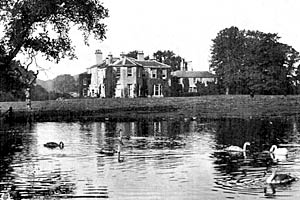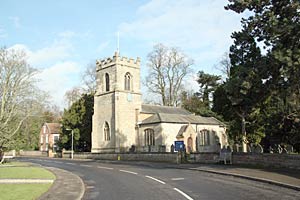< Previous | Contents | Next >
The Sherbrookes Through the Centuries

Oxton Hall in the mid-20th century.

Oxton church on 2011.
© Copyright Richard Croft and licensed for reuse under this Creative Commons Licence
OXTON. There is an air of content in this old-world village, where the church and the houses line the road, great trees make arches of living green, and the lanes, with their gorse and bracken, remind us that Oxton lies on the fringe of the old Sherwood Forest. Round about are ancient earthworks, with Oldox Camp in a hollow of the hills. Its age is unknown, and it was used perhaps as a place of safety for women and children in times of danger.
The hall, a fine house refashioned last century, looks out on a broad stretch of parkland with a lake made by the damming of a stream which runs through a shady plantation; and not far away an ivied stone archway, and a flagged path shaded by a yew said to be over 600 years old, make a charming approach to the small restored church.
The squat 14th century tower has battlements a century younger, and 13th century buttresses strengthen the north side of the church where a doorway of the same time opens to the light interior with its benches and box-pews. Between the clerestoried nave and its aisles are 14th century arcades. The chancel of crazy stone has a fine Norman arch and Norman masonry in the wall close by, a beautiful 13th century lancet deeply splayed, and a 600-year-old east window with St George, St Nicholas, and a soldier at the foot of the Cross.
It is the peace memorial. The altar table is Elizabethan. In harmony with the rest of the church is the dark oak of the low chancel screen (with a quaint minstrel on each side of the entrance), and of the stalls with a Bible inscription carved round the top, all of our day.
Some of the possessions of Oxton have had their queer adventures. A rare relic is a Norman shaft piscina found in a wall in the village, and the 14th century font has been used as a pump trough. There is a 17th century font, and the round Norman bowl of a third is on the floor. In the nave lies a stone man in a long gown, who may have been a judge in the 14th century; his feet are on a dog, and two headless angels support his pillow.
There are many memorials of the Sherbrookes who have lived here for centuries and were succeeded on the death of the last of them in 1847 by their cousin Henry Porter Lowe, who took their name. His brother Robert Lowe became Lord Chancellor and was made Viscount Sherbrooke; their father Robert Lowe, lying in Oxton churchyard, was one of the originators of the Poor Law system, and a keen follower of hounds he comes in Philip Pierrepont's hunting song in this way:
Next little Bob Lowe, on his little brown mare,
Comes, nicking across with all possible care.
In the chancel is a thrilling memory of the Great War, a wind-whipped flag which was the first to fly in Bagdad in 1917. It flew proudly at the mast-head of Henry Graham Sherbrooke's ship Tarantula during operations which resulted in the capture of Bagdad. Some of the treasures brought home by Commander Sherbrooke, DSO, are here under glass for us to see, a soldier-sailor's bag of souvenirs, including part of an inscribed brick from ancient Babylon. Another great soldier of the family was Sir John Coape Sherbrooke, who has been sleeping here since he died in 1830. He served in the Netherlands and the Mysore War, and was Governor-General of Canada in 1816.
Behind the wall, where the road goes to Southwell, is a stone tomb hobnobbing with the sheds of a farmyard. Under it lies Robert Sherbrooke who seems to have been an early nonconformist.
